An adverb is an independent part of speech. We use adverbs to tell more information about an action or object. Adverbs answer questions:
- how?
- when?
- why?
- where?
He regularly goes fishing.
We divide adverbs into groups according to their meaning. In this lesson we are talking about a very popular group of adverbs: these are adverbs of time.
What are adverbs of time?
Adverbs of time give us additional information about actions or events.
Remember to read How to learn English with audiobooks for FREE
Adverbs of time answer questions such as:
- When did it happen?
- How often does it happen?
- How long has it been going on?
The list of the most popular adverbs of the time includes:
- soon
- already
- tomorrow
- now
- early
- late
- seldom
- often
- hardly ever
- regularly
- occasionally
- constantly

Examples of adverbs of time with explanations
Look at examples of some popular adverbs with explanations to better understand how adverbs describe verbs.
I prepared well and was able to pass the exams afterward.
The adverb afterward describes the verb pass. By the way, note in this sentence there is another adverb that describes the verb prepared.
I didn’t go to work yesterday.
The adverb of time yesterday describes the verb go.
The train arrived later than expected.
In this example, the adverb later describes the verb arrived. Thanks to this, we understand when the train arrived.
If you want to get home before dark you have to leave soon.
The adverb soon describes the verb leave to indicate the time for the leave.
Peter, we’ll come back later.
The adverb later describes come back.
Why do you think you’ve heard this song before?
The adverb before describes the verb heard, helping us to get the exact answer to this question.
I will come tomorrow or the day after tomorrow.
The adverbs tomorrow and the day after tomorrow describe the verb come.
Two groups of adverbs of time
For ease of learning, let’s divide adverbs of time into two groups:
- Adverbs of definite time.
- Adverbs of indefinite time.
Let’s take a look at each of these groups separately.

Adverbs of definite time
Adverbs of definite time are adverbs that indicate a specific time when an action or event occurs.
For example, we can say:
John bought the car recently.
In this example, we are using an adverb recently. But does this adverb describe the verb buy precisely? After all, recently it could be two days ago or a month ago.
Therefore, such an adverb as recently is not an adverb of definite time. Recently does not give us a precise definition.
Let’s take a look at another example:
John bought the car 3 days ago.
3 days ago, this is also an adverb of time. Does this adverb describe the verb buy precisely? Yes, the adverb 3 days ago gives a precise definition. 3 days ago exactly answers the question When? After all, three days ago could only be three days ago. This is the most accurate description of the verb to buy.
Most often we use adverbs of definite time when we talk about the past or the future.
Yesterday I worked till 4 o’clock
Today I work till 4 o’clock
Tomorrow I will work till 7 o’clock
Adverbs of definite time can be simple, indicating a certain moment in time:
- Today
- Tomorrow
- Yesterday
Or more complex ones containing such additional words as this, that, last, next, ago, etc.
Using these words and adverbs of time, we can form many different combinations:
- last year
- next year
- last week
- next week
- last month
- next month
- last day
- next day
- a year ago
- a week ago
- a month ago
- a day ago
- this week
- this day
- this year
- this month
- five minutes ago
- two weeks ago
- four days ago
To form adverbs of time, we can use modifiers.
Modifier words are words such as:
- late
- later
- early
- earlier
- Punctually
- Exactly
etc.
These words help to change the meaning of a particular time.
With the help of these modifiers, we form additional combinations, such as:
- later this day
- earlier today
- later this week
- earlier that month
- exactly that day
- later this winter
- exactly two hours later
etc.
Also, some adverbs are formed using prepositions. For example, such prepositions as:
- at
- on
- in
With the help of such prepositions, we can form even more different combinations in order to determine time:
- At midnight
- At ten o’clock in the morning
- At dawn
- On the Sunset
- At the beginning of the year
- In a month
- At noon
NOTE: We may not pronounce the words last, next and the prepositions in, on, at in spoken English and informal writing:
See you next week.
this + specific time
When we define time using this + day of the week, we mean that we are talking about the next day of the week.
We cannot say this Tuesday if we mean not the next Tuesday but Tuesday in two weeks.
In such a construction, we can replace this with next without losing the meaning:
this Tuesday = next Tuesday
Many guests will come this Wednesday.
Many guests will come next Wednesday.
We use this rule when we talk about the month of the year. If we say this April, then we should mean exactly the next April and not April in a few years.
I will go to a new school this September.
It’ll be ten years old this October.
We can use in the present, future, or past tense such words and phrases as:
- this morning
- this afternoon
- this evening
- tonight
I gave him all the cases this morning.
Master says you may join the ladies this evening.
Adverbs of indefinite time
Adverbs of definite time indicate the exact moment of an action or event. Adverbs of indefinite time indicate NOT an exact, but an approximate moment of an action or event.
Take a look at an example:
John came to Japan three days ago.
The adverb three days ago is an adverb of definite time because it precisely defines the verb.
We know when it was because three days ago is always three days ago.
Take a look at another example:
John came to Japan recently.
The adverb recently describes the verb arrived. But this adverb does not accurately describe the verb. Recently it may have been three days ago or it may have been a month ago.
We refer to such adverbs as recently to the group of Adverbs of indefinite time. This group includes such adverbs as:
- afterward
- already
- another day
- another time
- at last
- at once
- early
- eventually
- formerly
- immediately
- instantly
- just
- late
- lately
- now
- nowadays
- once
- one day
- presently
- recently
- someday
- soon
- still
- straightway
- subsequently
- suddenly
- then
- these days
- ultimately
- yet
We use adverbs of indefinite time to describe actions and events in the future, present or past.
Let’s take a look at how we use indefinite adverbs:
Present Simple.
Indefinite Adverbs: now, presently, these days, already
These refugees are presently assisted by the governor.
Present Continuous.
Indefinite Adverbs: still, now, these days …
I am trying my best these days.
Present Perfect.
Indefinite adverbs: just, recently, already, yet.
I have recently discovered it missing from inventory.
Past simple.
Indefinite adverbs: late, suddenly, then, afterward, another day, early, eventually,
He suddenly collapsed during my lecture.
Future simple.
Indefinite adverbs: one day, ultimately, another day,
I will need another day with her.
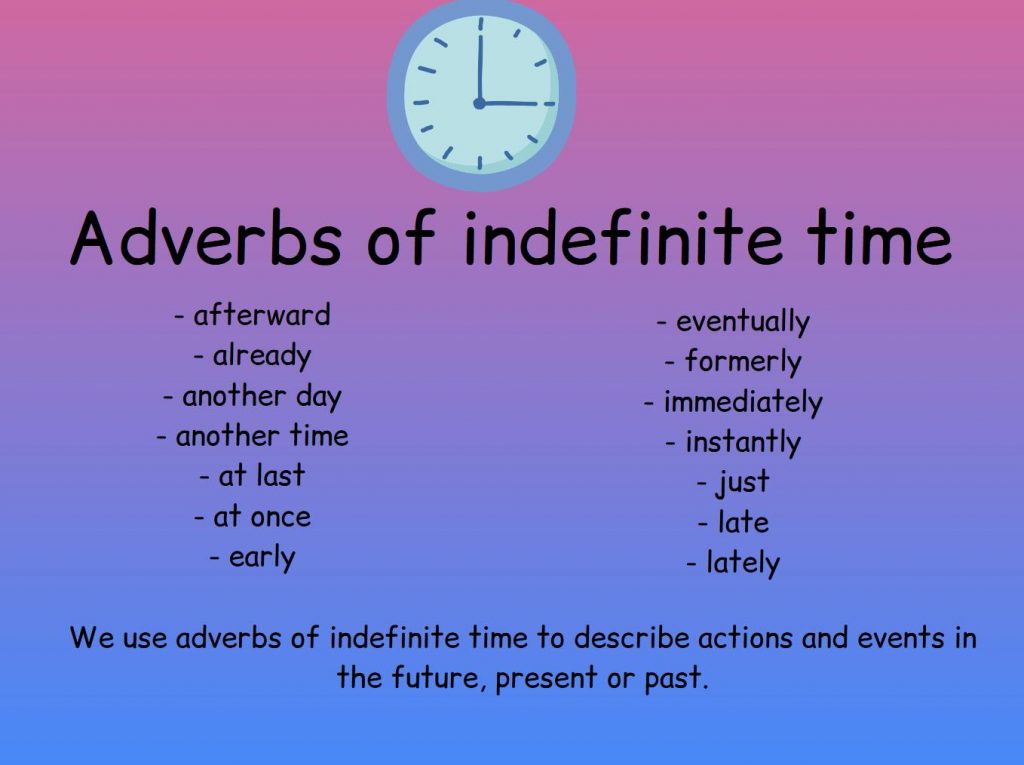
Adverbs of duration
We use adverbs of duration to express the duration of an action or event.
Duration adverbs indicate how long something lasts or does not last.
Often these adverbs are combinations of prepositions such as:
- for
- to
- till
- since
- by
- during
These prepositions are combined with adverbs such as:
- last day
- last week
- any more
- not anymore
- any longer
- not any longer
- no longer
- no more
- weeks ago
- all-day
- all night long
- days ago
- 5 days
Let’s take a close look at these combinations:
A moment in time + ago
We use a moment in time + ago to indicate when the action started to take place.
We use ago to refer to a point in time backward, into the past. The starting point of such a reference is the moment of speaking.
I got this job 4 years ago.
I started preparing for exams three days ago.
how long + ago.
We use how long + ago in questions to find out when an action has occurred.
We most often form the answer to this question using the Past Simple to indicate the exact time.
How long ago did you decide to change your job? – I decided it last summer.

The preposition since + some point in time
We use the preposition since + some point in time to indicate a specific point in time when the action started.
Typically, we use since + moment in time in such tenses as:
- Perfect present
- Perfect Continuous present
- Past Perfect
- Past Perfect Continuous
I haven’t spoken to Jessica since last summer.

All day / All night / All day long / All night long
We use All day / All night / All day long / All night long to indicate that some action lasted all day or all night.
We danced all night long.
He played tennis all day long.
We can change this combination. We can change the words day/night to week, year, etc.
He worked all week long.
But most of the time we use all with words like day or night.
The additional word long is optional. We use long to emphasize that the action lasted for the entire specified time.
He played tennis all day long = He played tennis all-day
No longer / Not any longer
We use no longer / not any longer to indicate a point in time beyond which the action cannot continue.
Often we put no longer / not any longer at the end of a sentence.
I could not stay any longer.
But you know, our affair could not last any longer.
John stops as he can run no longer.
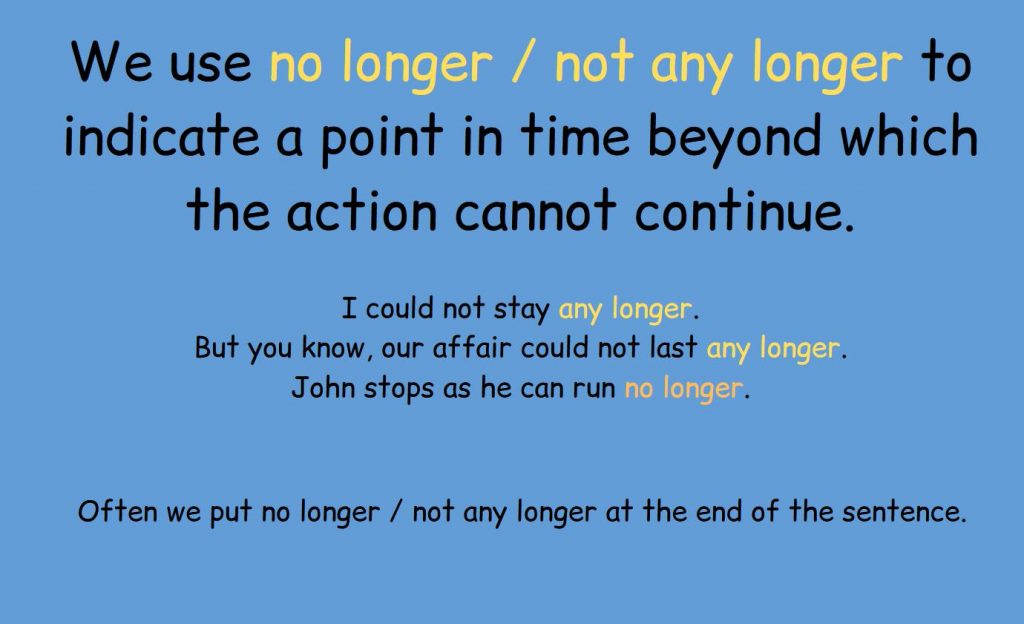
Not anymore
We use Not anymore as no longer / not any longer to indicate a point in time beyond which the action cannot continue.
More often we put Not anymore at the end of a sentence.
He won’t have you here, not anymore.
I’m not a soldier, not anymore.
For + Time period
We use for + time to indicate how long an action took from its beginning to its end.
We use for + time to form popular combinations:
- for months
- for days
- for hours
- for years
- etc.
Jessica hasn’t seen her family for months.
I cannot believe that someone has been watching me for two days.
We use this phrase in the present, future, and past:
I studied at this school for two years.
I have been studying at this school for two years.
I will study at this school for two years.
It’s not necessary to use for in spoken English in Present Perfect or Past Perfect with verbs that in themselves mean long actions. These are verbs such as:
- work
- stay
- wait
- be
- live
I have worked here for two years.
I have worked here two years.
I have lived there for 45 years, and I want to go home.
I have lived there 45 years, and I want to go home.
It’s not necessary to use for in affirmative sentences when talking about the future:
He will be with us for several days.
He will be with us several days.We will be your guests for two days.
We will be your guests two days.
ATTENTION: In negative sentences, we always say for!
Correct: Tom hasn’t done anything bad for two days.
Incorrect: Tom hasn’t done anything bad two days.Correct: I haven’t been on a date for 5 years.
Incorrect: I haven’t been on a date 5 years.Correct: You haven’t seen him for 3 weeks.
Incorrect: You haven’t seen him 3 weeks.

From + time + to / till / untill + time
We use from + point of time + to/till/until + point of time to indicate when the action started and until what point the action lasted.
We use from to indicate the point in time when the action started.
We use that, till or until to indicate up to what point the action took place.
We use this structure in the present, future, and past.
I studied at this school from October to/till April.
I study at this school from October to/till April.
I will study at this school from October to/till April.
Using these structures, it’s not necessary to pronounce from:
I will live with my parents in Hawaii June till July.
I will live with my parents in Hawaii from June till July.
The sentence without from sounds a little strange. But we really can say that without using from in spoken English.
By + time point + till / untill + time point
We use By + time point + till/until + time point to indicate the time when the action will end.
Please note that in English there is a group of verbs that in themselves imply duration. These are, for example, such verbs as:
- work
- stay
- wait
- be
- live
- study
etc.
We use till/until with these verbs.
We DO NOT use by with these verbs.I will study at this school till/until November.
I will play in this room till next year.
The whole / The entire
We use the whole / the entire as well as During / in or Throughout to describe a period or a point in time when an action occurred if the action occurred during the entire specified period.
We use the whole / the entire to emphasize that the action took place over the entire time.
I went fishing the whole / the entire summer.
I played video games the whole / the entire day.

During / in + noun
We use During / in + noun to describe a period or a point in time when an action took place.
Note: We use During / in with nouns only.
I lived with my grandmother during/in the summer.
I went fishing three times when I went to see my grandmother during/in the summer.
The summer is a noun that indicates when the action took place. Therefore, we can use during/in.
Throughout + noun
We use Throughout + noun to denote a period or a moment in time when an action occurred if this action took place during the entire named period.
I had a lot of fun with friends throughout the summer.
Adverbs of frequency
Adverbs of frequency describe how often something happens. These are such adverbs as:
- Often
- Always
- Usually
- Daily
- Annually
- Hourly
- Every minute
- Every day
- Every hour
- Every month
- Every year
- Once a week
- Once a month
- Once a year

Frequency adverbs are divided into:
- Adverbs of definite frequency.
- Adverbs of indefinite frequency.
Frequency adverbs determine exactly how often something happens or doesn’t happen. For example:
- Every hour
- Once month
- Daily
Adverbs of indefinite frequency describe approximately, not exactly, how often something happens or does not happen. For example:
- оften
- always
- usually
Adverbs of indefinite frequency depend on the opinion of the speaker.
This is logical. After all, when we say that something happens often or rarely, it always depends on what we mean by the words “often” or “rarely“.
For each person, “often” or “rarely” can mean a different period.
Adverbs of definite frequency do not depend on the speaker’s opinion.
When we say that something happens three times a week or every day, we all understand what it means.
We often use Adverbs of Frequency in the Present Simple.
I often have the same dream.
I often go downtown on Sunday.

Still and Yet
Still and Yet are very interesting adverbs. We use still and yet to indicate that an action in the past has already been completed or not yet completed.
We use yet most often in negative sentences and in interrogative sentences.
We use yet to express that someone is waiting for something that hasn’t happened yet.
When we use yet in interrogative sentences, we often expect to hear a negative answer.
Have we finished our meeting yet?
Have you told John the story yet?
I haven’t told John what happened to me yet.
We often use yet with Present Simple to indicate something that has not happened yet.
Still has a different meaning. We use still to indicate that something is still happening or not happening.
We use still to indicate that something hasn’t finished yet or that something hasn’t started to happen yet.
Mom is still in the supermarket.
In affirmative sentences, we put still before the main verb and after auxiliary verbs such as be, have, might, will, etc.
If the verb to be is the main verb in the sentence, then we usually put still after to be.
In interrogative sentences, we put still before the main verb.
When we use still in interrogative sentences, we expect the answer to be yes.
John is still waiting for you to call him.
The dog still wants to play with you.
Do you still play this computer game?
Do you still go to your grandma for the weekend?
I still want to sleep.
I have been preparing for exams for two months now but I am still not ready.
Are you still in this school?

When we use yet it means that there is something we are expecting. Something that we think will happen.
Has he called you yet?
He hasn’t called you yet.
We can use yet to answer the question of whether something has happened or not. But in this case, the answer must be negative:
Question: Have you seen him?
Answer: Not yet.
We put the adverb yet at the end of the sentence.
We usually use the adverb still in the middle of the sentence before a verb that denotes an action.
Order of adverbs of time
English is a very organized language. All parts of the sentence in English know their place 🙂
The adverbs of time also have their place and their order in an English sentence.
If we use more than one adverb of time together, then we use them in this order:
- Adverbs of time that answer the question How long.
- Adverbs of time that answer the question How often.
- Adverbs of time that answer the question When.

Place in a sentence of the adverbs often, usually, always
Let’s take a look at where we use popular adverbs of indefinite frequency often, usually, always.
We often use adverbs of indefinite frequency often, usually, and always in the Present Simple. Because often, usually and always mean regularity, constancy, periodicity. These are all signs of the Present Simple.
We use оften, usually, always before the main verb if the predicate in this sentence is expressed by a single verb.
I often go fishing.
I usually go fishing with my dad.
In interrogative sentences, we put оften, usually, always also in the middle of the sentence after the subject.
Do you usually go fishing with your dad or alone?
In short answers, we use оften, usually, always before an auxiliary verb if we want to emphasize that we agree or disagree with what we are asked.
Question: Do you visit your old school?
Answer: Yes I often do.
In negative sentences, we usually use often, usually, always after the negative not.
I’m not usually like this.
Survey information is not always perfect.
In affirmative sentences, we usually use оften, usually, always in the middle of the sentence before the main verb and after the auxiliary verb (if there is an auxiliary verb in the sentence).
I always love you!
I usually like my job.
I usually wear suits.
In some cases, we can put оften, usually, always at the end of the sentence.
He does answer his phone to me, usually.
In some cases, we can use оften, usually, always at the beginning of a sentence if such a sentence is imperative.
Always try to be rational.
We use оften, usually, always before the verb to be if the verb to be is the only verb in the sentence.
I always am a good boy!
If there is an auxiliary verb in the sentence (for example: am, is, will, have, etc.) then we use оften, usually, always after such a verb.
I will always watch over you.
Things don’t always work out as you think.
People don’t always swear the truth.
You don’t always say yes.
If the sentence contains a modal verb (for example: can, must, should, etc.), then we use оften, usually, always after such a verb.
You can usually make cappuccinos blindfolded.
He can’t always see what’s best for him.
You can’t always blame everything on your genes.
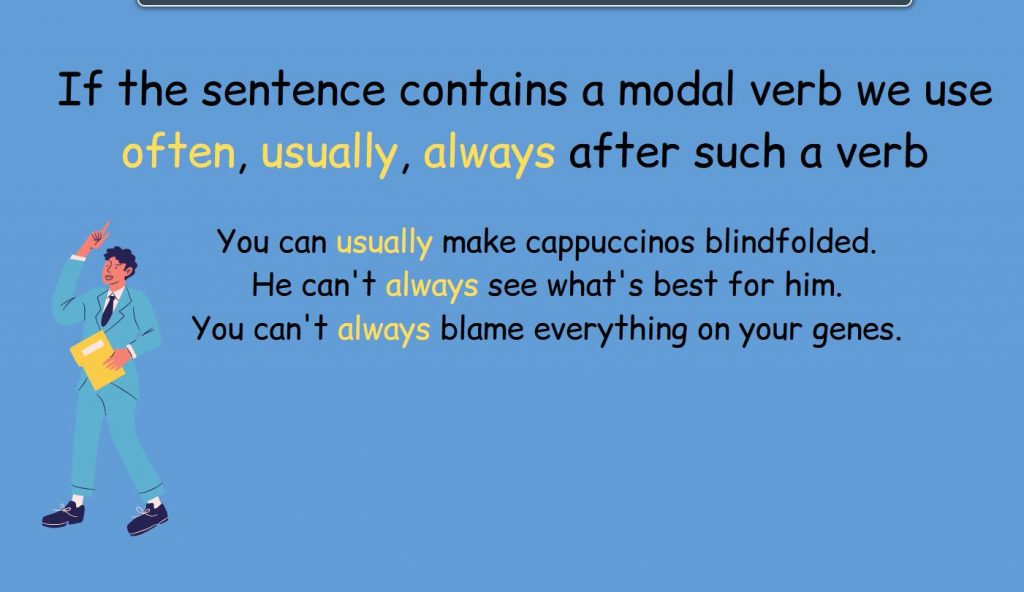
Hello! If you would like to thank me for the articles I wrote, you can click Buy me a coffee. Thank you! ❤❤❤

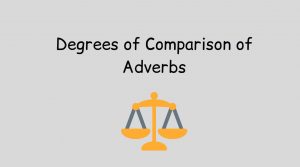


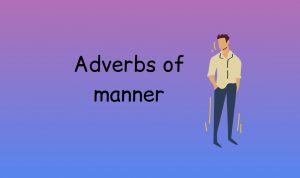


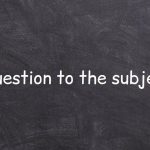



Wow that was strange. I just wrote an extremely long comment but after I clicked submit my comment didn’t show up. Grrrr… well I’m not writing all that over again. Anyhow, just wanted to say wonderful blog!